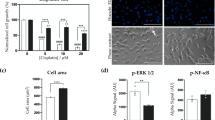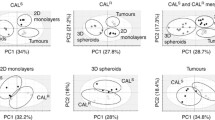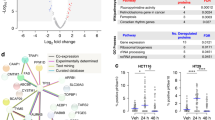Abstract
KTCTL-26 and KTCTL-2 are renal cell carcinoma (RCC) lines with high and lowexpression of P-170 glycoprotein, respectively. Inherent differences between the two cell lines in terms of phosphate metabolites and growth characteristics in culture were examined for possible association with multidrug resistance (MDR). Differences in response to drug treatment were investigated for 40 h incubations with various doses of vinblastine (VBL) alone or as cotreatments with various concentrations of the calcium antagonist diltiazem (DIL) and/or interferon–α (IFN-α). Treatment effects were quantitated using the MTT survival assay and 31P magnetic resonance spectroscopy (MRS) to determine phosphate metabolite profiles in intact cells. KTCTL-2 and KTCTL-26 cells exhibited significant inherent differences in phosphocholine, glycerophosphocholine, glycerophosphoethanolamine, and phosphocreatine levels. KTCTL-26 cells were more sensitive than KTCTL-2 to 0.011μM VBL alone (87% vs. 102% survival) or to 0.011μM BL + 10μM DIL (55% vs. 80% survival). The latter treatment resulted in a significant decrease in the ratio of phosphocholine to glycerophosphocholine in KTCTL-26 cells but no significant changes in phosphate metabolites in KTCTL-2 cells. Metabolomic 31P MRS detects different metabolite profiles for RCC cell lines with different MDR phenotypes and may be useful for noninvasive characterization of tumors in a clinical setting.
Similar content being viewed by others
References
Griniatsos J, Michail PO, Menenakos C, Hatzianastasiou D, Koufos C, Bastounis E (2003) Metastatic renal clear cell carcinoma mimicking stage IV lung cancer. Intl Urol Nephrol 35:15–17
Bichler K-H, Wechsel HW (1999) The problematic nature of metastasized renal cell carcinoma. Anticancer Res 19:1463–1466
Bak M, Efferth T, Mickisch G, Mattern J, Volm M (1990) Detection of drug resistance and P-glycoprotein in human renal cell carcinomas. Eur Urol 17:72–75
Kakehi Y, Kanamaru H, Yoshida O, Ohkubo H, Nakanishi S, Gottesman MM, Pastan I (1988) Measurement of multidrug-resistance messenger RNA in urogenital cancers; elevated expression in renal cell carcinoma is associated with intrinsic drug resistance. J Urol 139:862–865
Chabner BA, Fojo A (1989) Multidrug resistance: P-glycoprotein and its allies-the elusive foes. J Natl Cancer Inst 81:910–913
Mickisch GH (1993) Current status and future directions of research on multidrug resistance. The impact of contemporary biotechnology. Urol Res 21:79–81
Rothenberg M, Ling V (1989) Multidrug resistance: molecular biology and clinical relevance. J Natl Cancer Inst 81:907–910
Naito M, Tsuruo T (1989) Competitive inhibition by verapamil of ATP-dependent high affinity vincristine binding to the plasma membrane of multidrug-resistant K562 cells without calcium ion involvement. Cancer Res 49:1452–1455
Dalton WS, Sikic BI (1994) The multidrug resistance gene (MDR1) represents a potential target for reversing drug resistance in human malignancies. J NIH Res 6:54–58
Pastan I, Gottesman MM (1991) Multidrug resistance. Annu Rev Med 42:277–286
Horio M, Gottesman MM, Pastan I (1988) ATP-dependent transport of vinblastine in vesicles from human multidrug-resistant cells. Proc Natl Acad Sci USA 85:3580–3584
Mickisch GH, Roehrich K, Koessig J, Forster S, Tschada RK, Alken PM (1990) Mechanisms and modulation of multidrug resistance in primary human renal cell carcinoma. J Urol 144:755–759
Naito S, Koike K, Ono M, Machida T, Tasaka S, Kiue A, Koga H, Kumazawa J (1998) Development of novel reversal agents, imidazothiazole derivatives, targeting MDR1-and MRP-mediated multidrug resistance. Oncology Res 10:123–132
Silverman JA (1999) Multidrug-resistance transporters: In: Amidon GL, Sadee W (eds) Membrane transporters as drug targets, vol 12. Kluwer Academic/Plenum Publishers, New York, pp 353–386
Ernest S, Bello-Reuss E (1998) P-glycoprotein functions and substrates: Possible roles of MDR1 gene in the kidney. Kidney Int 53:S11-S17
Higgins CF, Gottesman MM (1992) Is the multidrug transporter a flippase? Trends Biochem Sci 17:18–21
Van Helvoort A, Smith AJ, Sprong H, Fritzsche I, Schinkel AH, Borst P, Van Meer G (1996) MDR1 P-glycoprotein is a lipid translocase of broad specificity, while MDR3 P-glycoprotein specifically translocates phosphatidylcholine. Cell 87:507–517
Fojo T, Bates S (2003) Strategies for reversing drug resistance. Oncogene 22:7512–7523
Negendank WG (1992) Studies of human tumors by MRS: A review. NMR Biomed 5:303–324
Kaplan O, Jaroszewski JW, Clarke R, Fairchild CR, Schoenlein P, Goldenberg S, Gottesman MM, Cohen JS (1991) The multidrug resistance phenotype: 31P nuclear magnetic resonance characterization and 2-deoxyglucose toxicity. Cancer Res 51:1638–1644
Le Moyec L, Tatoud R, Degeorges A, Calabresse C, Bauza G, Eugène M, Calvo F (1996) Proton nuclear magnetic resonance spectroscopy reveals cellular lipids involved in resistance to adriamycine and taxol by the K562 leukemia cell line. Cancer Res 56:3461–3467
Le Moyec L, Legrand O, Larue V, Kawakami M, Marie J-P, Calvo F, Hantz E, Taillandier E (2000) Magnetic resonance spectroscopy of cellular lipid extracts from sensitive, resistent and reverting K562 cells and flow cytometry for investigating the P-glycoprotein function in resistance reversion. NMR Biomed 13:92–101
Mannechez A, Collet B, Payen L, Lecureur V, Fardel O, Le Moyec L, De Certaines J-D, Leray G (2001) Differentiation of the P-gp and MRP1 multidrug resistance systems by mobile lipid 1H-NMR spectroscopy and phosphatidylserine externalization. Anticancer Res 21:3915–3920
Santini MT, Romano R, Rainaldi G, Filippini P, Bravo E, Porcu L, Motta A, Calcabrini A, Meschini S, Indovina PL, Arancia (2001) The relationship between 1H-NMR mobile lipid intensity and cholesterol in two human tumor multidrug resistant cell lines (MCF-7 and LoVo). Biochim Biophys Acta 1531:111–131
Venkatesan PV, Saravanan K, Nagarajan B (1998) Characterization of multidrug resistance and monitoring of tumor response by combined 31P and 1H nuclear magnetic resonance spectroscopic analysis. Anti-Cancer Drugs 9:449–456
Vivi A, Tassini M, Ben-Horin H, Navon G, Kaplan O (1997) Comparison of action of the anti-neoplastic drug Ionidamine on drug-sensitive and drug-resistant human breast cancer cells: 31P and 13C nuclear magnetic resonance studies. Breast Cancer Res Treat 43:15–25
DeVita VT, Hellman S, Rosenberg SA (1997) Cancer, principles and practice of oncology, vol 1 Lippincott-Raven, Philadelphia New York
Efferth T, Dunn TA, Berlion M, Langenbahn H, Pommerenke EW, Volm M (1993) Reversal of inherent multidrug-resistance in primary human renal cell carcinoma cell cultures by S 9788. Anticancer Res 13:905–908
Efferth T, Lohrke H, Volm M (1990) Correlations between natural resistance to doxorubicin, proliferative activity, and expression of P-glycoprotein 170 in human kidney tumor cell lines. Urol Res 18:309–312
Efferth T, Lohrke H, Volm M (1989) Reciprocal correlation between expression of P-glycoprotein and accumulation of rhodamine 123 in human tumors. Anticancer Res 9:1633–1637
Mosman T (1983) Rapid colorimetric assay for cellular growth and survival: Application to proliferation and cytotoxicity assays. J Immunol Methods 65:55–63
Frank MH, Pomer S (1999) Interferon alpha2b differentially affects proliferation of two human renal cell carcinoma cell lines differing in the P-glycoprotein-associated multidrug-resistant phenotype. J Cancer Res Clin Oncol 125:117–120
Franks SE, Kuesel AC, Lutz NW, Hull WE (1996) 31P MRS of human tumor cells: Effects of culture media and conditions on phospholipid metabolite concentrations. Anticancer Res 16:1365–1374
Kuesel AC, Donnelly SM, Halliday W, Halliday GR, Sutherland GR, Smith ICP (1994) Mobile lipids and heterogeneity of brain tumours as detectable by ex vivo 1H MR specroscopy. NMR Biomed 7:172–180
Shedd SF, Lutz NW, Hull WE (1993) The influence of medium formulation on phosphomonoester and UDP-hexose levels in cultured human colon tumor cells as observed by 31P NMR spectroscopy. NMR Biomed 6:254–263
Lutz NW, Kuesel AC, Hull WE (1993) A 1H NMR method for determining temperature in cell culture perfusion systems. Magn Reson Med 29:113–118
Kuesel AC, Graschew G, Hull WE, Lorenz W, Thielmann HW (1990) 31P NMR studies of cultured human tumor cells Influence of pH on phospholipid metabolite levels and the detection of cytidine 5’-diphosphate choline. NMR Biomed 3:78–89
Rofstad EK, DeMuth P, Fenton BM, Sutherland RM (1988) 31P nuclear magnetic resonance spectroscopy studies of tumor energy metabolism and its relationship to intracapillary oxyhemoglobin saturation status and tumor hypoxia. Cancer Res 48:5440–5446
Stryer L (1995) Biochemistry, 4th edn. WH Freeman and Company, New York
StatView (1999) Reference book. SAS Institute, Cary
Huland E, Heinzer H, Timm S, Aalamian M, Huland H (2002) Immuntherapie des metastasierenden Nierenzellkarzinoms in Deutschland. Urologe (A) 41:282–287
Krug J, Fritzsch J, Aust G (1995) Induction of insulin antibodies and insulin allergy under alpha-interferon treatment of renal cell carcinoma in a patient with insulin-treated diabetes mellitus - a case report. Int Arch Allergy Immunol 106:169–172
Podo F (1999) Tumour phospholipid metabolism. NMR Biomed 12:413–439
Mulquiney PJ, Kuchel PW (1999) Using the beta/alpha peak-height ratio of ATP in 31P spectra to measure free [Mg2+]: theoretical and practical problems. NMR Biomed 12:217–220
Willcocks JP, Mulquiney PJ, Ellory JC, Veech RL, Radda GK, Clarke K (2002) Simultaneous determination of low free Mg2+ and pH in human sickle cells using 31P NMR spectroscopy. J Biol Chem 277:49911–49920
Fogler WE, Pearson JW, Volker K, Ariyoshi K, Watabe H, Riggs CW, Wiltrout RH, Longo DL (1995) Enhancement by recombinant human interferon alfa of the reversal of multidrug resistance by MRK-16 monoclonal antibody. J Natl Cancer Inst 87:94–104
Kang Y, Perry RR (1994) Effect of alpha-interferon on P-glycoprotein expression and function and on verapamil modulation of doxorubicin resistance. Cancer Res 54:2952–2958
Lucero Gritti MF, Beviacqua M, Bordenave RH, Rumi LS (2001) Interferon-alpha 2b modulation of doxorubicin sensitivity in a multidrug resistant cell line. J Exp Clin Res 20:393–400
Hofmockel G, Bassukas ID, Wittmann A, Dammrich J (1997) Is the expression of multidrug resistance gene product a prognostic indicator for the clinical outcome of patients with renal cancer? Br J Urol 80:11–17
Oudard S, Levalois C, Andrieu JM, Bougaran J, Validire P, Thiounn N, Poupon MF, Fourme E, Chevillard S (2002) Expression of genes involved in chemoresistance, proliferation and apoptosis in clinical samples of renal cell carcinoma and correlation with clinical outcome. Anticancer Res 22:121–128
Giaccone G, Pinedo HM (1996) Reversal of MDR in solid tumors: In: Gupta S, Tsuruo T (eds) Multidrug resistance in cancer cells. Wiley, Chichester, pp 473–491
Abraham EH, Prat AG, Gerweck L, Seneveratne T, Arceci RJ, Kramer R, Guidotti G, Cantiello HF (1993) The multidrug resistance (mdr1) gene product functions as an ATP channel. Proc Natl Acad Sci USA 90:312–316
Hartmann JT, Bokemeyer C (1999) Chemotherapy for renal cell carcinoma. Anticancer Res 19:1541–1544
Efferth T, Thelen P, Schulten HG, Bode ME, Granzen B, Beniers AJ, Mertens R, Ringert RH, Gefeller O, Jakse G, Fuzesi L (2001) Differential expression of the multidrug resistance-related protein MRP1 in the histological compartments of nephroblastomas. Int J Oncol 19:367–371
Gottesman MM, Fojo T, Bates SE (2002) Multidrug resistance in cancer: Role of ATP-dependent transporters. Nat Rev Cancer 2:48–58
Kellen JA (1995) Alternative mechanisms of multidrug resistance in cancer. Birkhaeuser, Boston
Scheltema JMW, Romijn JC, Van Steenbrugge GJ, Beck WT, Schroeder FH, Mickisch GH (1997) Decreased levels of topoisomerase IIa in human renal cell carcinoma lines resistant to etoposide. J Cancer Res Clin Oncol 123:546–554
Scheltema JMW, Romijn JC, Van Steenbruggev, Schroeder FH, Mickisch GH (2001) Inhibition of apoptotic proteins causes multidrug resistance in renal carcinoma cells. Anticancer Res 21:3161–3166
Sikic B, Fisher GA, Lum BL, Halsey J, Beketic-Oreskovic L, Chen G (1997) Modulation and prevention of multidrug resistance by inhibitors of P-glycoprotein. Cancer Chemother Pharmacol 40:S13-S19
Cohen JS, Lyon RC, Chen C, Faustino PJ, Batist G, Shoemaker M, Rubalcaba E, Cowan KH (1986) Differences in phosphate metabolite levels in drug-sensitive and -resistant human breast cancer cell lines determined by 31P magnetic resonance spectroscopy. Cancer Res 46:4087–4090
Lavie Y, Fiucci G, Czarny M, Liscovitch M (1999) Changes in membrane microdomains and caveolae constituents in multidrug-resistant cancer cells. Lipids 34:S57-S63
Sharom FJ (1997) The P-glycoprotein multidrug transporter: interactions with membrane lipids, and their modulation of activity. Biochem Soc Trans 25:1088–1096
Ruiz-Cabello J, Cohen JS (1992) Phospholipid metabolites as indicators of cancer cell function. NMR Biomed. 5:226–33
Evelhoch JL, Keller NA, Corbett TH (1987) Response-specific adriamycin sensitivity markers provided by in vivo 31P nuclear magnetic resonance spectroscopy in murine mammary adenocarcinomas. Cancer Res 47:3396–3401
Tausch-Treml R, Kopf-Maier P, Baumgart F, Gewiese B, Ziessow D, Scherer H, Wolf KJ (1991) 31P nuclear magnetic resonance spectroscopy, histology and cytokinetics of a xenografted hypopharynx carcinoma following treatment with cisplatin: Comparison in three sublines with increasing resistance. Br J Cancer 64:485–493
Castaing M, Brouant P, Loiseau A, Santelli-Rouvier C, Santelli M, Alibert-Franco S, Mahamoud A, Barbe J (2000) Membrane permeation by multidrug-resistance-modulators and non-modulators: Effects of hydrophobicity and electric charge. J Pharm Pharmacol 52:289–296
Lo Y-L (2000) Phospholipids as multidrug resistance modulators of the transport of epirubicin in human intestinal epithelial Caco-2 cell layers and everted gut sacs of rats. Biochem Pharmacol 60:1381–1390
Romsicki Y, Sharom FJ (2001) Phospholipid flippase activity of the reconsituted P-glycoprotein multidrug transporter. Biochemistry 40:6937–6947
Senchenkov A, Litvak DA, Cabot MC (2001) Targeting ceramide metabolism - a strategy for overcoming drug resistance. J Natl Cancer Inst 93:347–357
Zhou Y, Gottesman M, Pastan I (1999) Domain exchangeability between the multidrug transporter (MDR1) and phosphatidylcholine flippase (MDR2). Mol Pharmacol 56:997–1004
Stein U, Walther W, Shoemaker RH (1996) Modulation of mdr1 expression by cytokines in human colon carcinoma cells: an approach for reversal of multidrug resistance. Br J Cancer 74:1384–1391
Monti F, Lalli E, Bontadini A, Szymczuk S, Pini E, Tononi A, Fattori PP, Facchini A, Ravaioli A (1994) Synergism between gamma interferon and doxorubicin in a human MDR colon adenocarcinoma cell line. J Chemother 6:337–342
Basting R, Corvin S, Haendel D, Hinke A, Schmidt D (1999) Adjuvant immunotherapy in renal cell carcinoma – comparison of interferon alpha treatment with an untreated control. Anticancer Res 19:1545–1548
Buzogany I, Czvalinga I, Gotz F (1997) Results of ambulatory mono- and combined interferon therapy in advanced kidney tumors. Orv Hetil 138:67–70
Jelic S, Babovic N, Stamatovic L, Kreacic M, Matkovic S, Popov I (2001) Vinblastin-carboplatin for metastatic cutaneous melanoma as first-line chemotherapy and in dacarbazine failures. Med Oncol 18:189–195
Ling V (1997) Multidrug resistance: Molecular mechanisms and clinical relevance. Cancer Chemother Pharmacol 40:S3–S8
Data Sheet Dilzem, Medsafe, 2002 (http://www.medsafe.govt.nz/DatasheetPage.htm)
Bennett CL, Vogelzang NJ, Ratain MJ, Reich SD (1986) Hyponatremia and other toxic effects during a phase I trial of recombinant human gamma interferon and vinblastine. Cancer Treat Rep 70:1081–1084
Gutterman JU, Fine S, Quesada J, Horning SJ, Levine JF, Alexanian R, Bernhardt L, Kramer M, Spiegel H, Colburn W, Trown P, Merigan T, Dziewanowski Z (1982) Recombinant leukocyte A interferon: Pharmacokinetics, single-dose tolerance, and biologic effects in cancer patients. Ann Intern Med 96:549–556
Nanus DM, Pfeffer LM, Bander NH, Bahri S, Albino AP (1990) Antiproliferative and antitumor effects of a-interferon in renal cell carcinomas: Correlation with the expression of a kidney-associated differentiation glycoprotein. Cancer Res 50:4190–4194
Author information
Authors and Affiliations
Corresponding author
Rights and permissions
About this article
Cite this article
Lutz, N., Franks, S., Frank, M. et al. Investigation of multidrug resistance in cultured human renal cell carcinoma cells by 31P-NMR spectroscopy and treatment survival assays. MAGMA 18, 144–161 (2005). https://doi.org/10.1007/s10334-005-0107-7
Received:
Revised:
Accepted:
Published:
Issue Date:
DOI: https://doi.org/10.1007/s10334-005-0107-7




